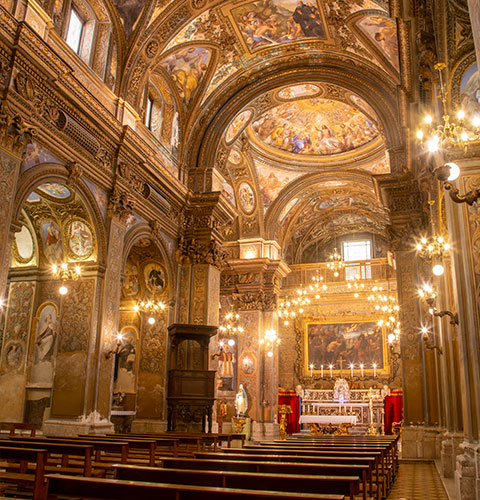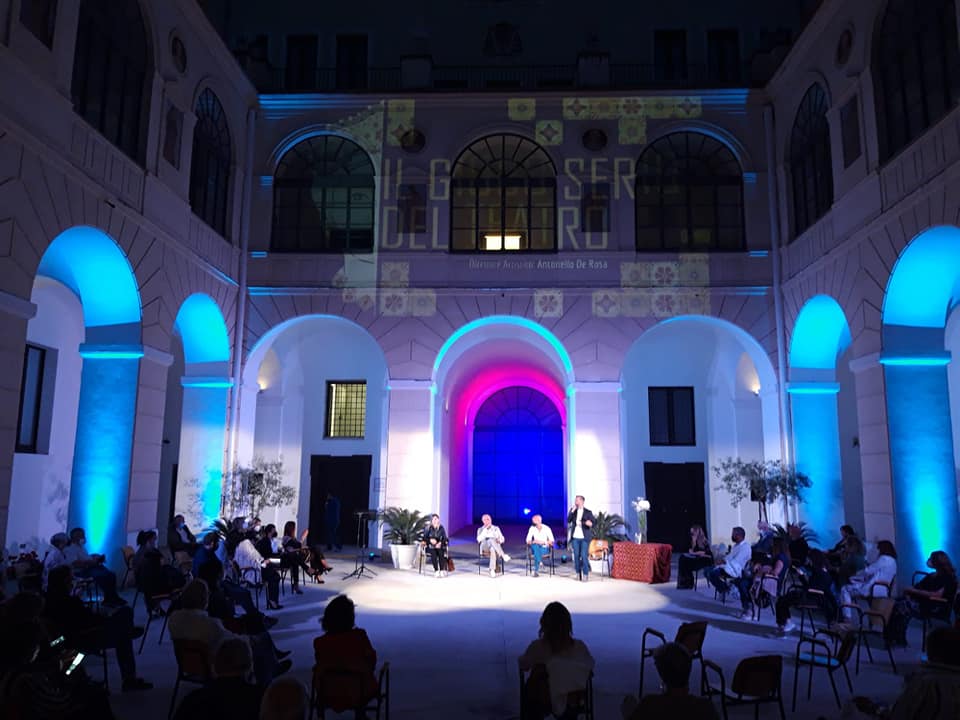A networking event with music, food and drink
Tuesday 16 September 2025
Church of Saint George [Google Maps] & Salerno Diocesan Museum [Google Maps]
The participants of the IBS-IR-EMR2025 conference are invited to visit the places in the historic center of Salerno with the musical entertainment of the Orchestra Ensemble Salernitano organized in the beautiful setting of the Church of Saint George, considered to be the most beautiful Baroque church in the city, a few hundred meters from the Cathedral of Saint Matthew.
Afterwards, the evening will continue with a convivial moment of networking to appreciate the architectural and culinary excellence of Campania at the Salerno Diocesan Museum, located in the center of Salerno (Largo Plebiscito, 12), behind the Cathedral of Saint Matthew. It is easily reached by walk in about 15 minutes from the Salerno train station and the conference venue.
Church of Saint George - a brief description

Saint George is the most beautiful Baroque church existing in Salerno, rich in frescoes of the highest quality. It was part of the convent of Benedictine nuns, now a barracks of the Guardia di Finanza and Carabinieri. It is one of the oldest monastic settlements of Salerno, which dates back to the early ninth century. To this period belong the remains of an apse frescoes, recently discovered in the church. At the end of the sixteenth century in San Giorgio are transferred all the nuns of the other Benedictine monasteries in the city (St. Sophia, St. Michael and St. Mary Magdalene). In 1711 the monastery was expanded with a new project elaborated by Ferdinando Sanfelice, the most famous Neapolitan architect of the first half of the eighteenth century. The interior is richly covered with murals and canvas paintings.
Among the other paintings in the church of great importance: The Virgin and Child with Saints and a nun praying by Andrea Sabatini, dated 1523, The Martyrdom of Saint George in capolatare dating back to the early decades of the seventeenth century, three paintings depicting San Gregorio Magno, the Holy Family with St. John, The Vision of St. Nicholas of Bari dated 1669, artworks by Giacinto De Populi, the Archangel Michael, dated 1690 by Francesco Solimena, some canvases portraying the Virtues, by Paolo De Matteis, dating from the early eighteenth century. Of particular value is the high altar in marble inlay with bas-reliefs and sculptures.
Salerno Diocesan Museum - a brief description

The Diocesan Museum is one of the most important repositories of works of art in Salerno. The actual location corresponds to the restoration of the structure of the Diocesan Seminary, a major cultural center of the city and the Province, together with the Library and Archives.
The current configuration of the building corresponds to the work contracted out in 1832 by Archbishop Lupoli. Following this restoration work, the complex has a strictly neoclassical physiognomy with symmetrical development built around the central axis of the door, on which stands keystone marble coat of arms of the prelate, and of the balcony above, framed by a newsstand that echoes a classical temple.
The artistic heritage of the Museum includes works that are from the Middle Ages to the twentieth century. There you can find:
- The Ivories of Salerno: the largest and most complete collection of stained glass tablets (first half of the XII century) of the Christian Middle Ages in the world. These are 67 pieces, 37 of which are illustrated with scenes from the Old and New Testament;
- An illuminated roll of the Exultet, divided into 11 parchment sheets illustrating the Easter Proclamation (proclamation of Easter), dating from the end of the first half of the thirteenth century;
- A painted cross (called of the Barliario), of the beginning of the eighteenth century;
- Paintings by Caravaggio school donated by the Marquis Giovanni Ruggi of Aragon in 1870 to the Cathedral of Salerno. These are mostly works of the seventeenth century. The main works are: the Judith, the David with the Head of Goliath, St. Jerome and St. Peter who cries for failing to recognize Jesus Christ and the painting of the biblical episode Lot and his daughters.
- Part of the collection of coins of Ancient Greece, the Roman Republic, the Roman Empire, and the Zecca of Salerno deserves to be admired. Among the thousands of coins is to point out the famous Follaro of Gisulfo II with the depiction of Opulent Salernu.
- In addition to the works exhibited the museum has paintings, mostly of wood and canvas, dating from the fourteenth to the twentieth century. Worth noting is also a Pontifical ad usum Ecclesiae Salernitanae.
To visit the Diocesan Museum, please check the visiting hours and the rates.